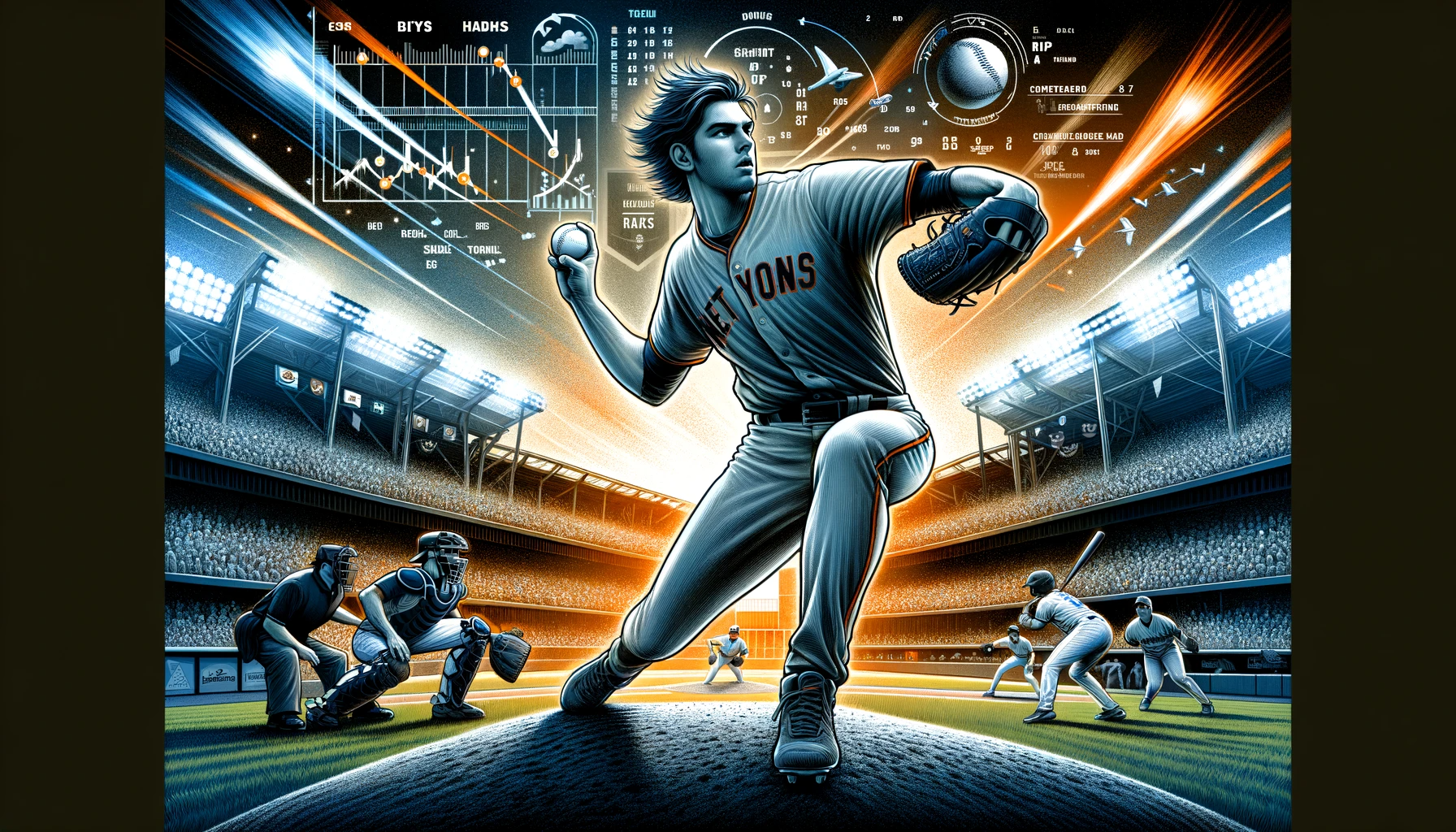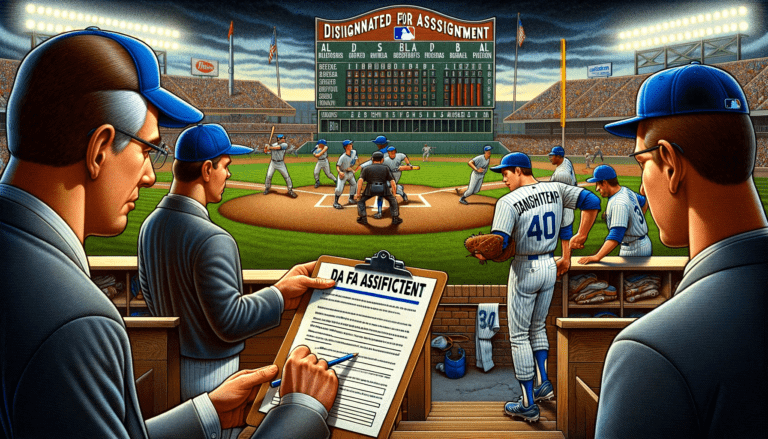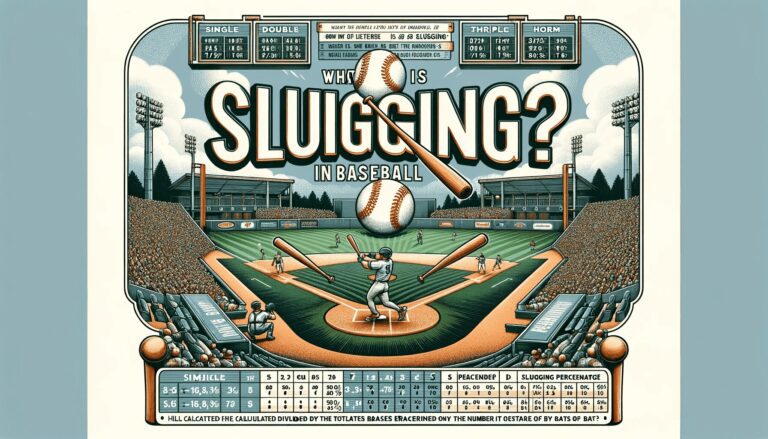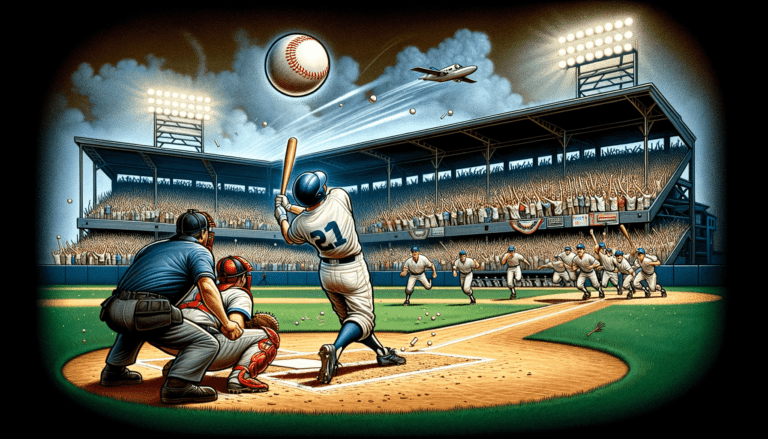What Does RHP Mean in Baseball?
RHP in baseball stands for “right-handed pitcher.” It’s a term used to describe pitchers who throw the ball with their right hand.
In baseball, pitchers are classified as either right-handed or left-handed. This distinction is important because it affects the way the pitcher delivers the ball to the batter and the way the batter needs to adjust their stance and swing.
Right-handed pitchers are more common in baseball, as the majority of players are naturally right-handed. However, left-handed pitchers can also be effective, as their delivery can be more deceptive for right-handed batters.
Understanding the meaning of RHP is essential for fans, coaches, and players alike, as it plays a crucial role in strategy and game planning.
Key Takeaways
- A successful RHP must master key pitching metrics such as ERA, WHIP, and K/BB ratio, which are crucial indicators of pitching effectiveness.
- Physical attributes like arm strength and endurance are essential, but mental toughness and the ability to manage game situations are equally important for an RHP.
- Strategic pitching involves analyzing hitter tendencies, working well with catchers, and adjusting approaches for different types of batters.
- The RHP has significant influence on team defense, being responsible for fielding their position, controlling the running game, and maintaining synergy with infielders and outfielders.
- Advanced metrics and scouting reports are vital for evaluating RHP performance and projecting future success, going beyond traditional statistics to provide a deeper understanding of a pitcher’s abilities.
The Fundamentals of Pitching: What Makes a RHP Effective

Understanding the Role of a RHP in the Game
In baseball, the right-handed pitcher (RHP) is a pivotal player on the field, responsible for setting the game’s tempo and directly engaging with every batter.
A RHP’s primary objective is to prevent the opposing team from scoring, by strategically delivering pitches that are difficult to hit.
The effectiveness of a RHP can be measured by key metrics such as ERA (Earned Run Average) and WHIP (Walks and Hits per Inning Pitched), which reflect their ability to limit the opposition’s offensive impact.
The role of a RHP extends beyond just throwing pitches; it includes understanding the batter’s strengths and weaknesses, and adjusting the pitching strategy accordingly.
This involves:
- Analyzing hitter tendencies
- Selecting the appropriate pitch type
- Choosing the right location to deliver the pitch
Moreover, a RHP must work in harmony with the catcher to call the game and make split-second decisions that can alter the course of an inning or even the entire game.
The synergy between pitcher and catcher is crucial, as it can dictate the outcome of each at-bat and ultimately the game itself.
Key Pitching Metrics: ERA, WHIP, and K/BB Ratio
In the realm of baseball statistics, a few key metrics stand out for evaluating the effectiveness of a right-handed pitcher (RHP).
Earned Run Average (ERA) measures the number of earned runs a pitcher allows per nine innings, serving as a fundamental indicator of a pitcher’s performance. A lower ERA signifies greater effectiveness in preventing runs.
WHIP, or Walks and Hits per Inning Pitched, combines the number of walks and hits a pitcher surrenders and divides it by the innings pitched.
This metric provides insight into a pitcher’s ability to keep runners off the bases, which is crucial for minimizing scoring opportunities for the opposition.
The Strikeout-to-Walk Ratio (K/BB) is another pivotal metric, highlighting a pitcher’s control and power.
It compares the number of strikeouts a pitcher achieves to the number of walks they issue. A higher K/BB ratio indicates a pitcher’s dominance over hitters and their precision in pitch placement.
The Importance of Pitch Selection and Location
The effectiveness of a right-handed pitcher (RHP) hinges significantly on their ability to master pitch selection and location.
Choosing the right pitch in a given situation can be the difference between a strikeout and a home run.
Pitchers must consider the batter’s weaknesses, the game context, and their own strengths when selecting a pitch.
Deception plays a crucial role in a pitcher’s success. By varying pitches and locations, a RHP can keep hitters off-balance, making it difficult for them to anticipate and make solid contact.
Here are some key points to consider:
- Mixing speeds to disrupt the hitter’s timing.
- Utilizing pitch movement to induce weak contact or swings and misses.
- Changing eye levels with high fastballs and low off-speed pitches.
- Working the corners of the strike zone to minimize hittable pitches.
Ultimately, the goal is to create a level of unpredictability that will lead to more favorable outcomes on the mound.
Read Also: What Does GIDP Mean in Baseball
Physical and Mental Attributes of a Successful RHP

Building Arm Strength and Endurance
For a right-handed pitcher (RHP), arm strength and endurance are critical components for sustained performance throughout the season.
Developing these attributes requires a dedicated regimen of exercises and practices. Pitchers often engage in long-toss programs to gradually increase the strength and resilience of their throwing arm.
This involves throwing the ball over increasing distances, focusing on proper mechanics to avoid injury.
In addition to long-toss, resistance training tailored to the unique demands of pitching can help build the necessary muscle groups.
Exercises such as shoulder presses, rotator cuff workouts, and scapular stabilization drills are commonly incorporated into a pitcher’s routine.
Grip strength training, highlighted by exercises like grip strengtheners, wrist curls, and towel hangs, specifically targets the muscles in the hands, forearms, and shoulders.
Recovery is just as important as the workouts themselves. Adequate rest, proper nutrition, and physical therapy techniques such as icing and massage ensure that a pitcher’s arm remains in peak condition.
Consistency in these practices is key to developing the arm strength and endurance needed to excel on the mound.
Mental Toughness and Game Situation Management
The ability to maintain focus and composure in high-pressure situations is a defining characteristic of a successful RHP.
Mental toughness is not just about enduring stress; it’s about thriving under it. This quality allows pitchers to execute their game plan regardless of the game’s stakes.
- Positive Self-Talk: Reinforcing confidence through affirmative statements.
- Situational Awareness: Understanding the context of the game to make better decisions.
- Emotional Control: Keeping a level head to manage the highs and lows of a game.
Developing these mental skills is as crucial as physical training. A pitcher’s mindset can be the difference between a win and a loss, especially in moments that test their resilience and adaptability.
The Impact of Pitching Mechanics on Performance
The efficiency of a pitcher’s mechanics can have a profound effect on their performance. Proper pitching mechanics are essential for maximizing velocity and control while reducing the risk of injury.
A pitcher’s ability to consistently deliver the ball with power and precision stems from a well-coordinated sequence of movements.
Key elements of pitching mechanics include the pitcher’s stance, leg kick, arm angle, and follow-through.
Each component must be finely tuned to work in harmony:
- The stance sets the foundation for stability and balance.
- The leg kick initiates momentum and helps generate power.
- Arm angle affects the trajectory and movement of the pitch.
- A controlled follow-through ensures energy is efficiently transferred to the ball and helps protect the arm from injury.
Pitchers often work with coaches to analyze and refine their mechanics, using video analysis and biomechanical data to make precise adjustments.
This attention to detail can lead to significant improvements in performance and longevity in the sport.
See Also: What Does BB Mean in Baseball
Strategic Aspects of Right-Handed Pitching

Analyzing Hitter Tendencies and Exploiting Weaknesses
A right-handed pitcher (RHP) must be adept at analyzing hitter tendencies to gain a competitive edge.
This process is crucial for identifying patterns in a batter’s behavior that can be used to the pitcher’s advantage.
For instance, understanding whether a hitter struggles with off-speed pitches or tends to chase balls outside the strike zone can inform pitch selection.
Key steps in this analysis include:
- Reviewing video footage of previous at-bats.
- Studying advanced statistics such as OPS (On-base Plus Slugging) and BABIP (Batting Average on Balls In Play).
- Consulting scouting reports for insights on a hitter’s strengths and weaknesses.
By combining these data points, a RHP can develop a tailored approach to each at-bat, aiming to exploit favorable matchups.
This strategic preparation often translates into better performance on the mound, as pitchers can induce more swings and misses or weak contact, leading to outs.
The Significance of the Pitcher-Catcher Dynamic
The pitcher-catcher dynamic is a cornerstone of baseball strategy and game management. A harmonious relationship between the pitcher and catcher can significantly influence the outcome of a game.
They must work in unison to outsmart batters, with the catcher guiding the pitcher through pitch selection and location.
- The catcher is responsible for understanding the pitcher’s strengths and preferences, often discussing strategies before each game.
- During the game, the catcher’s ability to frame pitches and control the running game can be pivotal.
- Trust and communication are key, as the catcher must accurately interpret the pitcher’s needs and relay signs effectively.
An improved rapport between the pitcher and catcher can lead to enhanced performance, as seen when a catcher’s defensive plays, such as throwing out runners, complement the pitcher’s efforts on the mound.
This synergy is not only crucial in tight games but also in building a pitcher’s confidence over the season.
Adjusting Strategies Against Left-Handed vs. Right-Handed Batters
A right-handed pitcher (RHP) must tailor their approach when facing left-handed and right-handed batters. The angle of delivery and the pitch’s movement can be perceived differently by batters, depending on their stance.
For instance, a curveball breaking away from a left-handed batter might be more effective than the same pitch to a right-handed batter.
- Against left-handed batters, RHPs often rely on pitches that break away from the batter, such as sliders or cutters.
- When facing right-handed batters, they may prefer pitches like two-seam fastballs that break in towards the hitter’s hands.
In general, a left-handed batter has a better view and therefore more success against a right-hand throwing pitcher.
Since there are many more right-handed pitchers, left-handed batters can capitalize on this familiarity. RHPs must be aware of these dynamics and adjust their pitch selection and location accordingly to maintain an edge.
Read Also: What Does R Mean in Baseball
RHP’s Influence on Team Defense and Game Dynamics

Fielding Responsibilities and Pivotal Plays
A right-handed pitcher (RHP) is not only the spearhead of the pitching staff but also a critical fielder once the ball is in play. Their ability to field their position can be the difference between a win and a loss.
For instance, a well-executed pickoff move to first base can erase a base runner and change the momentum of an inning. Similarly, a pitcher’s quick reflexes on a comebacker can lead to a pivotal double play.
Key fielding responsibilities for a RHP include:
- Covering first base on ground balls to the right side
- Fielding bunts and making accurate throws to the bases
- Backing up bases on throws from the outfield
These actions require not only physical agility but also a sharp mental acumen to anticipate plays and make split-second decisions.
The synergy between an RHP and the infielders is particularly important during shifts and when orchestrating plays to counteract the opposing team’s strategy.
Controlling the Running Game and Holding Runners
A right-handed pitcher (RHP) plays a crucial role in controlling the running game, which can significantly impact the momentum and outcome of a baseball game.
Effective management of base runners requires a combination of skills and strategies.
- Quick and deceptive pickoff moves are essential to keep runners close to the base, reducing their chances of successfully stealing.
- Varied timing and delivery to the plate can disrupt the runner’s rhythm, making it harder for them to predict the pitcher’s move.
- Communication with infielders is key to executing pickoffs and defending against the steal.
By mastering these techniques, RHPs can deter runners from taking extra bases, thereby limiting the opposing team’s scoring opportunities.
The ability to hold runners effectively also relieves pressure on the catcher, allowing them to focus on framing pitches and calling the game.
Synergy with Infielders and Outfielders
The right-handed pitcher (RHP) is a central figure in orchestrating the defense on the field. Effective communication and trust between the RHP and the defensive lineup are crucial for seamless play execution.
This synergy is not only about covering bases and fielding batted balls but also involves anticipating each other’s moves and backing up plays.
- A RHP must be aware of the defensive positioning and strengths of each infielder and outfielder.
- They should work closely with the catcher to understand the game plan and adjust fielder alignment accordingly.
- During the game, the RHP’s ability to read the batter and pitch accordingly can set up infielders and outfielders for success, turning potential hits into outs.
The collaboration extends beyond the physical aspects of the game. It includes the mental preparation and strategic discussions that happen off the field, which can have a significant impact during critical moments of the game.
For instance, a RHP’s insight into a batter’s tendencies can inform infield shifts or outfielder positioning, leading to a more effective defense.
Read Also: What is MVR in Baseball
Evaluating RHP Performance: Advanced Metrics and Scouting Reports

Beyond Traditional Stats: Understanding Advanced Metrics
In the modern era of baseball analytics, traditional statistics like ERA and WHIP are being complemented by a suite of advanced metrics that offer a deeper insight into a pitcher’s performance.
Advanced metrics such as On-base Plus Slugging (OPS), Batting Average on Balls in Play (BABIP), and Isolated Power (ISO) are now crucial for evaluating a RHP’s effectiveness.
These metrics provide a more nuanced view of how a pitcher controls the game.
For instance, OPS combines on-base percentage (OBP) and slugging percentage (SLG) to measure a player’s overall offensive value.
While BABIP can indicate how much luck is involved in a pitcher’s success or struggles.
ISO quantifies a batter’s raw power by calculating the average number of extra bases a player earns per at-bat.
Understanding these advanced statistics is essential for scouts, coaches, and analysts alike. They help in making informed decisions about player development, game strategy, and roster construction.
As the game evolves, so does the sophistication of the tools we use to understand it, with metrics like Statcast offering even more detailed breakdowns of player abilities.
The Role of Scouting Reports in Assessing RHP Talent
Scouting reports are a critical tool for evaluating the potential and current skill level of right-handed pitchers (RHPs).
These reports provide a comprehensive analysis that goes beyond basic statistics, offering insights into a pitcher’s mechanics, velocity, pitch repertoire, and mental makeup.
Scouts look for nuances that numbers alone can’t reveal, such as a pitcher’s ability to handle pressure or the effectiveness of their off-speed pitches in game situations.
Key elements included in scouting reports are:
- Pitcher’s physical attributes and potential for growth
- Technical analysis of pitching mechanics
- Assessment of mental toughness and on-field demeanor
- Historical performance against various levels of competition
By combining these qualitative assessments with quantitative data, organizations can make more informed decisions on which RHP talents to invest in.
Scouting reports are particularly valuable for projecting future success and identifying areas for development, ensuring that prospects have the guidance they need to refine their skills and advance through the ranks.
Projecting Future Success: From Minor Leagues to the Majors
The journey from the minor leagues to the majors is a critical phase in a pitcher’s career, where potential is honed into performance.
Scouts and analysts closely monitor a prospect’s development, assessing their readiness for the big leagues.
Key indicators of future success include:
- Consistent improvement in pitching velocity and control
- Development of secondary pitches, such as a slider or changeup
- Ability to adjust strategies and learn from each outing
For a right-handed pitcher (RHP), these indicators are scrutinized through game performance and advanced metrics.
For instance, a pitcher who has increased their fastball velocity while maintaining accuracy is likely to catch the attention of major league scouts.
Similarly, the effectiveness of a pitcher’s off-speed pitches can be a deciding factor in their progression.
The MLB Farm System Rankings often highlight prospects who have made significant strides, such as RHP Chandler Champlain, who is noted for his potential.
As these young talents continue to evolve, their trajectory towards the majors becomes clearer, with each game serving as a stepping stone towards their ultimate goal.
Conclusion
In conclusion, RHP in baseball stands for “Right-Handed Pitcher.” It refers to a pitcher who throws the ball with their right hand.
This term helps distinguish between pitchers who throw with their right hand and those who throw with their left hand (referred to as LHP, or “Left-Handed Pitcher”).
Understanding this distinction is essential for baseball fans and analysts when discussing the game and evaluating players.
Frequently Asked Questions
What is a RHP in baseball?
RHP stands for Right-Handed Pitcher. It is a term used to describe a pitcher who throws the ball with their right hand, which can influence the game dynamics, especially in matchups against batters.
What are some key pitching metrics for evaluating RHP performance?
Key pitching metrics include ERA (Earned Run Average), WHIP (Walks and Hits per Innings Pitched), K/BB (Strikeout-to-Walk Ratio), OBP (On-base Percentage), SLG (Slugging Percentage), and advanced metrics like OPS (On-base Plus Slugging).
How important is pitch selection and location for a RHP?
Pitch selection and location are crucial for a RHP as they determine the effectiveness of each pitch, help in exploiting the hitter’s weaknesses, and are essential for strategic pitching and game management.
What physical and mental attributes contribute to a RHP’s success?
Successful RHPs typically have strong arm strength and endurance, mental toughness, the ability to manage game situations, and refined pitching mechanics that contribute to their overall performance on the mound.
How does a RHP influence team defense?
A RHP influences team defense by their ability to field their position, control the running game, and hold runners on base. Their synergy with infielders and outfielders is also key in defensive strategies and pivotal plays.
What is the role of scouting reports in assessing RHP talent?
Scouting reports play a significant role in assessing RHP talent by providing detailed analyses of their mechanics, repertoires, and performance against batters, which helps in projecting their future success from the minor leagues to the majors.







